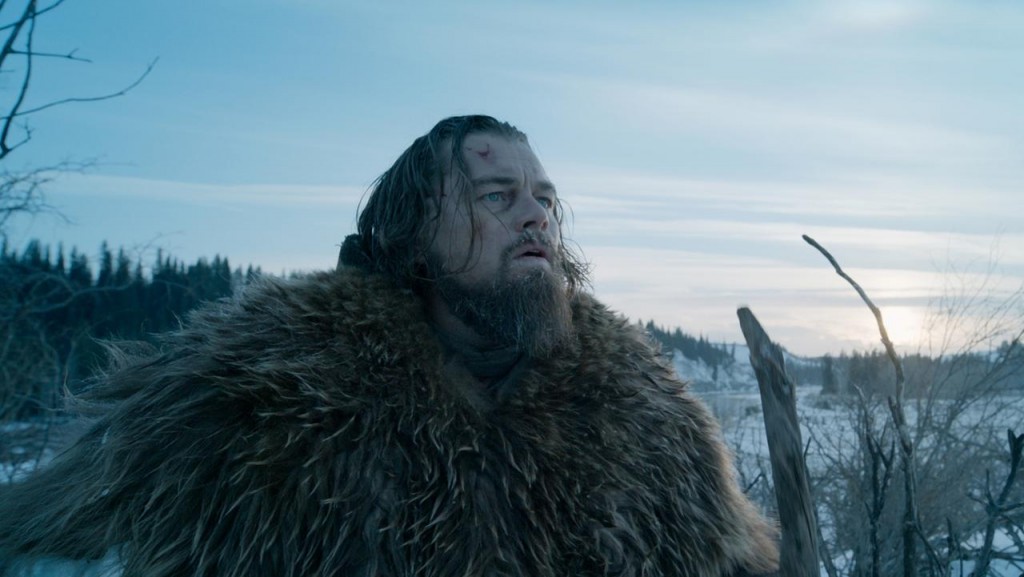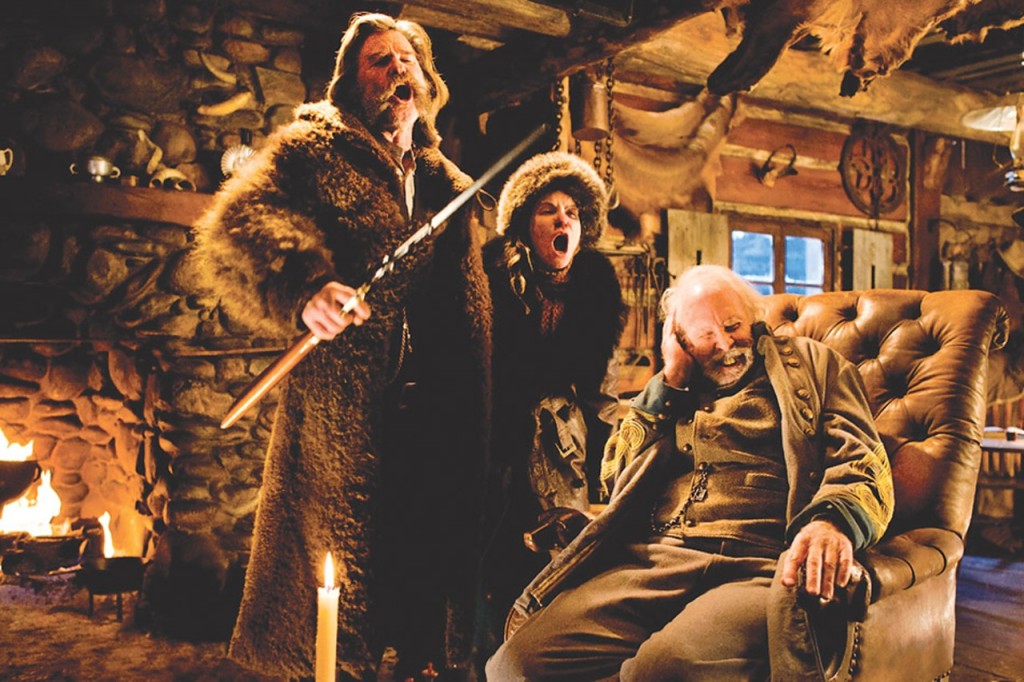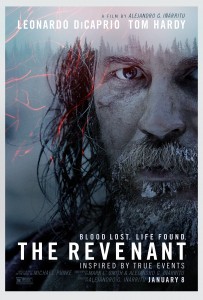I’ve come to admire Evan Cogswell’s perceptive reflections on film. He blogs over at Catholic Cinephile, participates in daily discussion at Arts & Faith, and is a generous Looking Closer Specialist. I’m grateful for his friendship, support, and insight.
Evan’s recently he’s made some intriguing comments about some of 2015’s biggest big-screen events. When he mentioned that he was writing down some thoughts on why he thinks Quentin Tarantino’s controversial new close-quarters epic The Hateful Eight is a more successful work of art than Alejandro Innaritu’s The Revenant, I invited him to share those thoughts here, and he graciously accepted.
I had seen The Revenant the night before, and the more I thought about it, the more dissatisfied I became with Innaritu’s decisions. (I posted some off-the-cuff notes at Letterboxd.) And I see here that Evan has some of the same reservations I did regarding the disconnect between the film’s visual splendor and its narrative aspirations. But he’s taken the time to develop his critique much more completely. (And he’s way ahead of me on another point: He’s seen The Hateful Eight.)
Here’s Evan:
This year’s award season has seen the release of two Westerns – both from fairly talented if flamboyant filmmakers, both set in the merciless winter, both about mankind’s capacity for evil, both featuring remarkable cinematography, and both featuring deliberate and prominent religious references. Yet, for all these similarities between Alejandro G. Iñárritu’s The Revenant and Quentin Tarantino’s The Hateful Eight, I found the Tarantino film to be far more rewarding, thought provoking, and most importantly a successful piece of filmmaking. The simple reason for this is that The Hateful Eight accomplished exactly what it set out to, and The Revenant did not.
The first and most obvious point of comparison, and the one that gave me the idea for this essay, is the cinematography. Emmanuel Lubezki’s work for The Revenant is undeniably beautiful, and the wide angle lenses he uses capture the vastness and beauty of the snow-covered plains and forests as well as the peace and beauty of the sunlight and water. To some extent Lubezki captures Hugh Glass’ (DiCaprio) feeling of isolation, but that is undermined when the camera moves in for extreme close-ups while maintaining the wide angle lenses. It wastes the field of vision, and even more distractingly, Iñárritu chooses to have the actors breathe on the lens as if to remind us that the shoot took place on location, and it was really cold and really difficult.
Another point of distraction is that the frequent worm’s-eye-view of trees is copied from the gorgeous work Lubezki did for Malick’s The New World. Finally The Revenant’s beautiful cinematography becomes monotonous, mostly because it starkly contrasts the dark, brutal nature of the story: a man mauled by a bear, then betrayed and left for dead, finds the will to survive so he can take vengeance on the man who murdered his son. That is simply not a beautiful story, and trying to portray it as such comes across like the creepy kid from American Beauty.
In stark contrast, The Hateful Eight is fully aware of the ugliness of its story, and the cinematography reflects that. Like Lubezki in The Revenant, cinematographer Robert Richardson opens with wide angle shots that reflect vast landscape, but the darker lighting overshadows the natural beauty. If my memory’s correct, there’s only one scene in The Hateful Eight in which the sun brightly illuminates the landscape, which is kept in sharp focus by the wide angle lenses Richardson uses for that scene, and it’s arguably the most horrifying scene in the movie. However, that scene is the one where Tarantino’s theme becomes abundantly clear: all of these characters are equally depraved and repellent, and their hatred for one another will lead to their demises.
As that hatred leads to acts of vengeance and brutality, Richardson shifts to longer lenses, which make the film seem more oppressive as the set and the characters close in on one another. This is especially clear when John Ruth “The Hangman” (Kurt Russell) boasts that he is bringing Daisy Domergue (Jennifer Jason Leigh) to hang, and he states that anyone who tries to stop him will be killed. Russell and Leigh stand in the middle of the haberdashery, the walls closing in upon them, and the other characters pushed out of the frame. They believe they are the center of the story, and their hatred leaves no room for anyone else. The next major scene with Russell and Leigh takes this to an even greater level, as a smaller area of the haberdashery takes up even more of the frame. If it’s not clear from the story itself, the cinematography makes it blatant: the hatred on display is suffocating not only for the characters but the audience as well.
I do not mean to suggest that Lubezki’s cinematography in The Revenant is bad; on the contrary, it displays tremendous skill. I do think it is badly misapplied to the story Iñárritu is trying to tell. Similarly, there is no denying both Iñárritu and Tarantino have much talent as directors. Even though neither of these films is my favorite of their work, both films clearly show someone who knows how to use a camera, has a distinctive visual flair, and works well with actors. However, both directors suffer from a similar immaturity and weakness: they cannot resist showing off. With Tarantino that showing off usually appears in his scripts, and with Iñárritu it appears in difficult, technically impressive, and distracting camera techniques.
For last year’s Birdman, a film I liked immensely, Iñárritu crafted a script which played to his strengths as a filmmaker and mostly obscured his weaknesses. The Revenant’s script is a conglomeration of ideas and themes about justice, revenge, divine providence, and survival which at times feels more like a list of ideas than an actual story. It neither works on its own, nor does it hide Iñárritu’s flamboyant showing off. The aforementioned fogging of the camera is just one example.
Another example is the early battle scene which is shot mostly in one long take. As the camera follows the actors, the feeling is not one of excitement or dread for the characters, but a feeling of curiosity, wondering how Iñárritu managed to work all the special effects into that take without stopping to edit. The perpetual wide angles serve as a constant reminder that The Revenant was shot on location, which did not draw me into the story, but simply made me feel sorry for the actors due to the cold in which they obviously had to work.
As several reviews have already pointed out, Tarantino’s immature penchant for blurring the line between disgust and pleasure is on display in The Hateful Eight, and there are some scenes where he is clearly using the adjective in the film’s title to get away with showing some, well, hateful behavior which we really did not need to see. The scene shot in bright sunlight that I referenced above is the most glaring example, even if it explicitly drives home the theme of film. Another scene draws a blatant parallel between the racism of the past and today’s Black Lives’ Matter movement. It’s a worthy point, but I don’t disagree with those who argue Tarantino is using that as his excuse for throwing the n-word into the script every few sentences.
In spite of all that, the depravity on display does add to the movie’s central point: racism, misogyny, and all other forms of hatred are destructive to society and to individuals. As those attitudes play out in multiple quests for vengeance, the depravity escalates to the horrific finale. Tarantino even reins in his normal aestheticized violence, replacing it with much nastier realistic violence. It may be unpleasant, but everything serves the story.
On the other hand, the story of The Revenant, while also about revenge and dehumanizing acts of violence does not progress naturally to its finale. We see many scenes which are meant to impress upon us the extreme lengths which DiCaprio went to for the sake of the movie, (which will almost definitely win him an overdue Oscar) but none that lead up to his final act. Without giving any spoilers, it’s the type of act which Christian film critics often like to discuss and rave about, especially considering the reference he makes to God as being in control of life. However, it all comes completely out of left field, as if “ambiguously-motivated-quasi-spiritual-moment” was the last box Iñárritu felt compelled to check off.
The repetition of one line from earlier does not add continuity to DiCaprio’s final act, especially considering the first utterance of that line was followed by a brutal act of violence which completely contradicts the supposed mercy which the line offers. When DiCaprio’s character repeats the line, it does not come across as profound, but as a lazy paraphrase of Batman’s final line to Ra’s Al Ghul in Batman Begins.
The Hateful Eight also has religious references, which are better integrated into the film. The film opens with a shot of a wooden crucifix covered in snow, setting the stage for a movie in which all the characters think of themselves as their own saviors, and Tarantino returns to that idea and to the crucifix several times. The shots of the crucifix may have been tacked on, (I don’t think they were) but when you add something at the beginning of the film and return to it, it influences everything we see after it. When you add something new at the end, it comes across as an afterthought to pander to a certain audience.
When I walked out of The Revenant, my first comment was, “It’s like watching a talented director trip over himself. You can kind of see what he’s attempting, but his desire to show off his talent is getting in his way.” When I walked out of The Hateful Eight, my initial reaction was, “It contains some of Tarantino’s trademark immaturity, but the vicious realism of the violence might make this his most conscientious film yet.” After a few weeks of reflection, I think both those first impression were pretty accurate.
As I said, the stories of both films concern dehumanizing violence and acts of vengeance, but that vengeance is approached quite differently. Considering Tarantino’s penchant for graphic violence, I admit that from a basic description of the plots, The Revenant sounds like it should be the more rewarding viewing experience. However, the integration of all elements in service of the story, for me, made The Hateful Eight far more worthwhile.
As one last example, consider the scores; the score for The Revenant is good music which creates atmosphere as it partially recalls native American indigenous music, but it’s laid over the film without adding much to the characters or the story. Morricone’s sinister contrabassoon theme is flawlessly integrated throughout The Hateful Eight, creating both mood and enhancing character development.
When I was doing my undergrad, I took a course in which six student composers each composed incidental music for one of the drama school’s six plays during that school year. The first thing we learned for all composers, sound technicians, lighting designers, and anyone else who works behind the scenes was this rule: never, ever do anything that draws attention to itself and takes the audience’s attention away from what’s happening on stage. That rule also applies to film, and The Revenant breaks it repeatedly. The Hateful Eight does not.




I agree with: “The repetition of one line from earlier does not add continuity to DiCaprio’s final act, especially considering the first utterance of that line was followed by a brutal act of violence which completely contradicts the supposed mercy which the line offers.” But I was also consoled that The Revenant was not just another Mel Gibson revenge-porn-flick by Inarritu’s statement to Film Comment: “I didn’t have a problem when I was younger with thinking that the Western’s ideal of revenge as a goal – as something that would be accomplished, and then order is restored, everyone lives happily ever after – was okay. As an adult, I definitely have a problem with that now.”
I let myself get caught up in Tarantino’s revenge scenarios during Basterds and Django, and I was captivated as if driving by a grisly car wreck during Hateful Eight, but I don’t ever need or want to see Hateful Eight ever again nor recommend it because it was just too simplistic. The one character who changes a little bit from his racist outlook was tough to care about. It was like watching a cockroach war for three hours, if those cockroaches were extremely verbose. The one highlight for me was Bob the Mexican’s last line. Loved the score, too.
On the other hand, three days after seeing it, images in The Revenant are not going away. Some sequences are living in me now like The New World and Tree of Life, though I’m thankful there was no narration from DiCaprio. I feel like I have to see it again, and I want to tell others about it. I’m glad I got to talk about it with a friend I saw it with because he saw things I completely missed. We wondered, “Was that a meteor streaking across the sky?” Herzog says human beings need new images, and that’s what Inarritu and Lubeszki have provided with amazing consistency: “I’ve never seen anything like that before.”
Thanks for your thoughtful comment, Jeremy. I appreciate Inarritu’s comment, and I wish I saw more of it in the movie. Some of the images have stayed with me as well (mostly the ones copying Malick, and of course the bear attack and extreme closeups of Leo’s face), but they still impress me only superficially – as in, this is really incredible and impressive to look at, not in a way that draws me into the world of the film.
Having seen them both, I really appreciate this entry.
The Hateful Eight bothered me. Its characters are unlikable, the violence is unflinching and the ending straddles a fine line between nihilism and a thoughtful commentary on a uniquely American brand of hate. But aside from a moment of unnecessary narration, I was never taken out of the movie. Tarantino, working with a top-notch cast and crew, wrapped me around his finger, pushed my buttons and made a movie that shook me.
The most damming thing I can say about “The Revenant” is that it provoked no emotional response in me whatsoever, aside from irritation that I’d just spent nearly three hours on what I call a doughnut movie — some nice material (cinematography, performances) surrounding an empty center. I’m glad Evan brought up the moment where Dicaprio’s character breathes on the lens…it’s a startling break in the film’s reality. Leo’s a great actor, but he’s failed by the movie’s script, which trades in banal cliches about revenge. The visuals are beautiful, sure, but I agree that they are familiar — it felt like a movie Terence Malick might have made as an angry teenager. Also, I agree with Devin Farci at birthmoviesdeath who said that a great cinematic shot only works in context — and there’s no deeper meaning to the beautiful images here.
I would have rather the focus on Hugh Glass been moved to the background and the film dealt with Tom Hardy and Will Poulter’s characters. They both give really good performances and Poulter’s character is the only one with any internal conflict.
I try not to over intellectualize films because then you miss out on the energy of the film. Emotionally I thought the Revenant was more substantial, maybe not to the point where you feel like cry but at least you feel the sense of pain from Hugh’s loss. I felt nothing for any of the characters in The Hateful Eight and at the end when they all died I couldn’t help feel that it was a pointless movie with really nothing to say about anything except now we know Tarantino loves old westerns. But didn’t we know that already? Why make movies that lead you on for 3 hours like there is some semblance of mystery when there really is none. If that means accomplishing what you set out to do then please tell me what could he have been trying to do with this one except shoot a movie on 70 mm that had no reason to be shot that way.